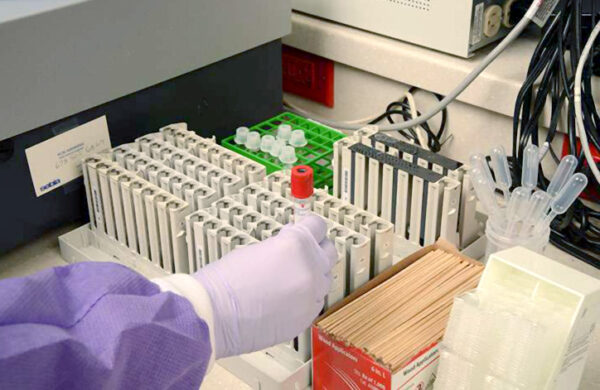Your Resources
Lymphoma
Blood Cancer (Lymphoma) Treatment in Huntsville Alabama and Other Locations
Lymphoma

Lymphoma is the most common type of cancer in the lymphatic system, which is part of the body’s germ-fighting network, in the U.S. Lymphoma is cancer involving cells of the immune system called lymphocytes. The lymphatic system includes the lymph nodes or glands, spleen, thymus gland, and bone marrow; lymphoma can affect all of these areas as well as other organs throughout the body.
Causes of Lymphoma
Although there is no known cause for lymphoma, what we do know is that it begins when a disease-fighting white blood cell called a lymphocyte develops a genetic mutation. This mutation tells other cells to multiply rapidly, causing many diseased lymphocytes to increase in number.
This means that the mutated cells go on living while normal cells would die, creating a network of too many diseased and ineffective lymphocytes in your lymph nodes causing your nodes, liver, and spleen to swell.Lymphoma can be categorized as Hodgkin or Non-Hodgkin. While the two types may share some of the same symptoms and treatment options, your healthcare provider will determine the type of lymphoma and discuss which treatment is best for that particular type.
Hodgkin’s Lymphoma
The most common symptom of Hodgkin’s disease is an enlarged lymph node in the neck, under the arm, or in the groin. The lump may grow larger or smaller surrounding lumps may also appear. Swollen lymph nodes may also be due to an infection, so please visit your health care provider if you feel enlarged lymph nodes. Other symptoms associated with Hodgkin’s disease are:
- Fever that is not associated with an infection
- Night sweats that drench the sheets
- Unexplained weight loss
- Fatigue
- Persistent cough
- Difficulty breathing
- Chest pain
- Severe and constant itching
Non-Hodgkin’s Lymphoma
Symptoms of non-Hodgkin’s lymphoma can vary depending on its location in the body. These symptoms do not necessarily mean you have lymphoma and could be caused from another underlying health condition. Please consult your health care provider if you have any of the following symptoms:
- Enlarged lymph nodes
- Chest pain
- Shortness of breath or persistent cough
- Fever that is not associated with an infection
- Weight loss
- Night sweats resulting in drenched sheets
- Swollen stomach or a fullness feeling after only a small amount of food
- Low red blood cell count
Hodgkin’s Lymphoma
There are several risk factors associated with Hodgkin’s disease. Having one of these risk factors does not necessarily mean you will get the disease, but if you have any of these risk factors, please discuss them with your health care provider.
- Family history – an identical twin has a high risk of developing Hodgkin’s disease if the other twin is diagnosed. Also, brothers and sisters of a young person diagnosed with Hodgkin’s have an increased risk of developing the disease
- HIV, Hepatitis A, Hepatitis B – the risk is greater in patients infected with HIV
- Geography – Hodgkin’s is most common in the U.S., Canada, and northern Europe. It is least common in Asian countries
- Epstein-Barr virus – patients that have been infected with the Epstein –Barr virus, also known as mono, have an increased risk of developing the disease
Non-Hodgkin’s Lymphoma
There are several factors that may affect a person’s chances of getting non-Hodgkin’s lymphoma. Just because you may have one or more of the following risk factors, does not necessarily mean you will develop lymphoma. Please discuss with your health care provider if you have any of the following risk factors:
- Race/ethnicity – white people are more likely to get non-Hodgkin’s lymphoma than African Americans or Asian Americans
- Chemical exposure – exposure to certain herbicides and insecticides, along with benzene exposure, may be linked to an increased risk for non-Hodgkin’s lymphoma
- Radiation exposure – patients that have been previously treated with radiation therapy and people that have been exposed to nuclear accidents have an increased risk
- Weakened immune systems
- Certain autoimmune diseases
- HIV patients
- Obesity
- High fat diets
Hodgkin’s Lymphoma
Unfortunately there are no screening tests for Hodgkin’s disease, but paying close attention to symptoms associated with the disease will help increase the chances of catching it in its early stages. Treatment options vary for each patient depending on the patient’s health or the stage of the disease. Treatment options for Hodgkin’s disease include:
Non-Hodgkin’s Lymphoma
As with Hodgkin’s disease, there are no screening tests available for non-Hodgkin’s disease, but paying close attention to the symptoms can help catch the disease in its early stages. Treatment for non-Hodgkin’s lymphoma will vary from patient to patient depending on the stage of the disease and the health of the patient. Treatment options can include one or more of the following:
Survival Rate
There is an International Prognostic Index (IPI) that doctors use to determine the outlook for patients with fast-growing, aggressive, lymphomas as well as slow-growing, such as follicular lymphomas. The IPI allows doctors to plan treatments better and figure out what kind of schedule is needed. Below are 5 factors this index depends on:
- The patient’s age
- The stage of lymphoma
- Whether or not the lymphoma is in organs outside the lymph system
- Performance status – how well can this person complete normal daily activities?
- The blood level of lactate dehydrogenase (LDH), which increases with the amount of lymphoma in the body
These factor help categorize each patient for their prognosis. Their characteristics are important to understanding survival rates, which vary greatly due to the many things this depends on. It is difficult to put an exact survival rate percentage on this disease, however, using this IPI can help doctors and patients understand what they are up against.
